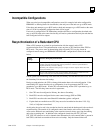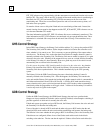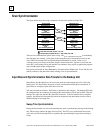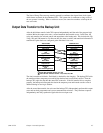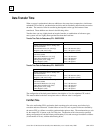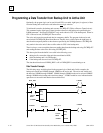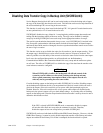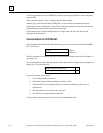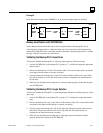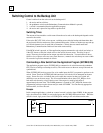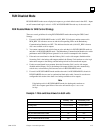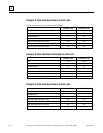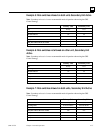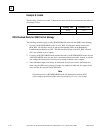
GFK-1527A Chapter 4 Normal Operation 4-11
4
Disabling Data Transfer Copy in Backup Unit (SVCREQ #43)
Service Request function block #43 can be used on the backup to allow the backup unit to bypass
the copy of the shared I/O data from the active unit. This function can be used to help determine if
the active and backup CPUs are arriving at the same results.
This function is useful only when issued in the backup CPU. It is ignored if issued when the units
are not synchronized, or if it is issued in the active unit.
SVCREQ #43 disables the copy of data for 1 sweep beginning with the output data transfer and
ending with the input data transfer of the next sweep. The copy can be disabled for multiple
sweeps by invoking SVCREQ #43 once each sweep for the appropriate number of sweeps.
The special resynchronization data transfer always occurs, even if SVCREQ #43 is invoked in the
first sweep after synchronization (this data transfer includes all shared inputs, all shared outputs,
and internal data which must be exchanged) since the resynchronization data transfer occurs before
the start of logic execution.
This function can be set up to disable the copies for all transfers or just the output transfers. If just
the output copy is disabled, the two units can still use the same set of inputs on each unit. This
makes it possible to test the ability of the two units to derive the same results from the same inputs.
In all cases, the configured data transfers are still transferred over the Redundancy
Communications Module / Bus Transmitter Module link every sweep and the rendezvous points
are still met. The effect of SVCREQ #43 is to disable the copy of the data from the transfer to the
actual reference memories configured.
Warning
When SVCREQ #43 is in effect, the backup unit will still take control of the
system in event of a failure or role switch. Switches to the backup unit may
cause a glitch (momentary interruption of data) of the outputs since the two
units may not be generating the exact same results.
Consider disabling outputs on the backup unit while SVCREQ #43 is in effect. Disabling outputs
on the backup unit eliminates the risk of an unsynchronized switch of control (which can cause a
glitch in the outputs) if the active unit fails or loses power while the input/output copies are
disabled. However, if the active unit does fail or loses power while outputs are disabled on the
backup unit, the system's outputs will go to their default settings. A secondary effect of disabling
outputs on the backup unit is that the unsynchronized fault action table is used by the active unit to
determine which faults are fatal.
Note
If the CPU is already in RUN/ENABLED mode, a command to disable its outputs
will not take effect until one sweep after the command is received. Therefore,
disable the outputs at least one sweep before you enable SVCREQ #43.
SVCREQ #43 can be used with both the GHS and the GDB Control Strategies. However, with the
GDB Control Strategy, it cannot be used to disable output data transfer on the Primary unit when
outputs are enabled on the Primary Unit. If that is attempted, the function block is rejected.



